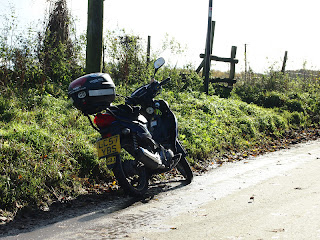It's OK for me to ride as it has no clutch, and I like it anyway as it's light and easy to ride and can be dragged out of dirt or picked up easily, should the need arise. That makes it very useful for poking about remote lanes and villages where falling off is high on the 'likely' list.
So today, starting on 19000 miles dead, I rode her up onto the North Downs in rural Kent, on a very bright but blustery autumn day, with big black clouds interspersed with sunbursts and blue sky.
And it was cold. So cold that I actually wore my winter gloves and about 200 jumpers. But I was still cold. My plan was to wend my way to Kent via the A and B roads to Dode, a village abandoned during the Black Death plague in about 1350. It's not far - maybe 25 miles/45kms from home.
There must have been a storm last night because there was so much debris on the roads. Far more leaves and branches than normal and lots of standing water, even on well used roads. Perhaps it was the tail end of that storm they had on the east coast of America; we usually get their leftovers in the UK, courtesy of the south westerly prevailing winds.
I followed the A25 down through Westerham, Braestead and Sundridge, to Riverhead and Seal, before turning off at Wrotham to climb up onto the North Downs. I stopped briefly at Westerham and snapped a picture of Churchill
and General James Wolfe,

,
both commemorated here on the Green, by separate statues. Churchill lived just down the road at Chartwell, whilst Wolfe lived in Quebec House, which was his childhood home. And if you haven't already made the connection, Wolfe was the bloke who sorted out the French in the Seven Years War, and the Battle of Quebec, which prompted the French to hand over their land possessions in Canada to the Brits.
Westerham is only a small place but it boasts two men who at different times, made a huge impact on the World and helped shape modern history. It also has some very nice teashops but I didn't stop at any today as I'd only just left home.
By the time I reached the lanes not far from Wrotham, evidence of last night's rain was all around. I stumbled across several puddles like these, dotted around. And yes of course I rode through it but didn't get a picture as it would have meant riding no handed and even I think that is beyond the call of duty. Probably.
I just waited for an obliging car to rock up to save me walking through to test the depth as it was too cold for a swim and I had my new camera to think about.
But the views from the top of the Downs were worth the effort.
It's funny what you find hidden away in familiar places. I have passed signposts for this place so many times but have never gone to see what lies along that lane. But it was a little church alongside a farm, right in the middle of nowhere.
And Pizzabike had a bit of a pose in the sunshine.
I dropped down into Rochester, which I hadn't meant to do, but having ended up there, I had a quick look at the Castle and the Cathedral. Both are really impressive and overlook the River Medway.
But those clouds were getting blacker and blacker and gathering over the river. This bit of the river was famous in the early days of aviation when the Short brothers opened a factory on the banks, just downstream. This is where they pioneered the piggy back system that the Americans later used to launch the space shuttle. Only the Short brothers, back in the day, developed it in order to run an airmail postal service across the Atlantic, using a modified Sunderland flying boat - Maia - and a small seaplane - Mercury. Maia carried Mercury and then Mercury took off from it, thus extending its range. Simple, effective and ingenious.
And you know that feeling of annoyance when you know you're about to get a good soaking.......
.....well I didn't as it somehow bypassed me.
But it produced some spectacular light which made even the roadside weeds look interesting.
This is the M2 bridge - in its day, the longest span bridge of its type in the World back in the 1960s. Looks tiddly now though.
I eventually reached the bit of the Downs that I had been looking for although I couldn't find Dode, although I knew it was very nearby. A combination of being cold and wanting to get home before the sun went down and it got even colder, meant that I gave up without too much of a search; I'll save that for another day. But I did stop at Paddlesworth Church, which is in the same parish as Dode. And it was open too, much to my surprise, so I spent 15 minutes inside, out of the wind, and having a look around.
Again, it was in the middle of nowhere. Its about 900 years old, although some bits are probably a bit older. The village that it served was wiped out during the Black Death, and it was amalgamated with Dode Parish afterwards. Its still a consecrated church although no longer used for worship, and for about 250 years, was used by the nearby farm as a barn. But it was empty today.
So that was it. Time to head for home, after a round trip of just under 100 miles/164 kms. And I still didn't get wet. Excellent!


















